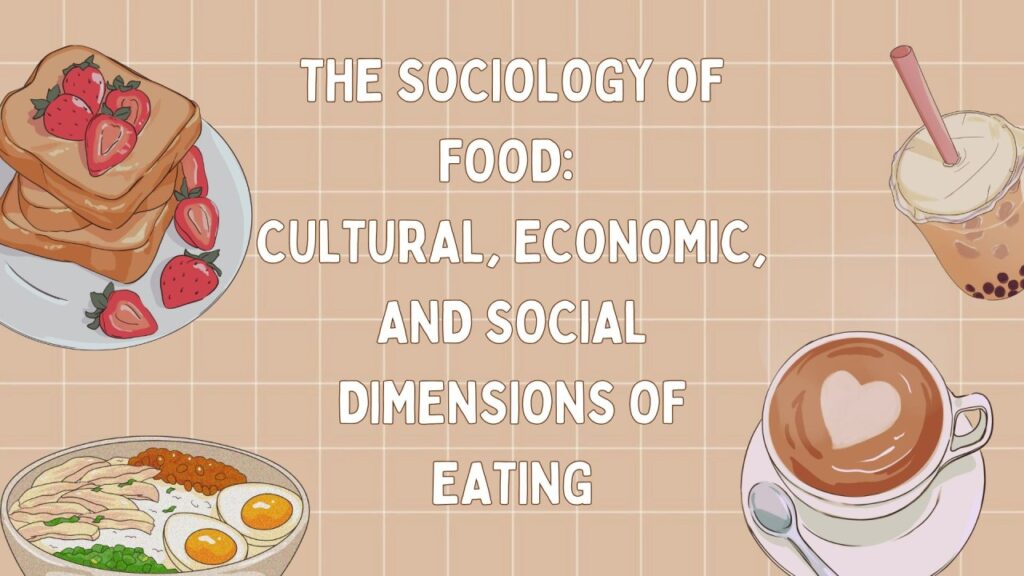Food is a universal necessity, but its role extends far beyond mere sustenance. The sociology of food explores how our eating habits are shaped by a web of cultural, economic, and social factors. In this exploration, we will delve into how these dimensions intersect, influence each other, and shape our relationship with food. By understanding these dynamics, we can appreciate the profound significance of what and how we eat in contemporary society.
Cultural Dimensions of Eating
Food as an Expression of Identity
Food is a powerful expression of cultural identity. What we eat, how we prepare it, and even the rituals surrounding meals are deeply rooted in our cultural heritage. For example, the traditional Japanese tea ceremony is more than just drinking tea; it is an art form that embodies harmony, respect, purity, and tranquility. Similarly, Mexican cuisine, with its rich use of spices, tortillas, and beans, reflects the country’s indigenous heritage and colonial history.
In many cultures, food is used to mark significant life events. In India, festivals like Diwali and Holi are celebrated with an array of sweets and savory dishes, each symbolizing joy, prosperity, and togetherness. The American Thanksgiving dinner, with its turkey, stuffing, and pumpkin pie, commemorates a historical feast and embodies themes of gratitude and family unity.
Globalization and Culinary Exchange
The globalization of food has led to a fascinating culinary exchange, where ingredients and cooking techniques from one part of the world are adopted and adapted in another. Sushi, once a Japanese delicacy, is now enjoyed globally, with variations like the California roll reflecting local tastes. Conversely, pizza, originally from Italy, has been reinterpreted in countless ways around the world, from the New York slice to the deep-dish Chicago style.
However, this exchange is not without its controversies. The concept of cultural appropriation in food arises when traditional dishes are commercialized by those outside the culture, often without understanding or respecting the original context. For instance, the commercialization of Native American cuisine by non-Native chefs has sparked debates about authenticity, respect, and ownership.
Economic Dimensions of Eating
The Industrialization of Food Production
The industrialization of food production has dramatically transformed our food landscape. Mass production and global supply chains have made food more accessible and affordable, but they have also raised concerns about quality, sustainability, and ethics. The rise of fast food chains like McDonald’s epitomizes this transformation, offering convenience and low prices but often at the expense of nutritional value and environmental impact.
The demand for cheap, readily available food has led to practices like factory farming, where animals are raised in confined spaces with minimal regard for their welfare. This has sparked movements advocating for organic farming, local sourcing, and fair trade, emphasizing the need for ethical and sustainable food production.
Food Deserts and Inequality
Economic disparities are starkly reflected in food access. Food deserts, urban areas where residents have limited access to affordable and nutritious food, are a glaring example of how socioeconomic status affects diet. In these areas, convenience stores and fast-food outlets outnumber grocery stores, leading to diets high in processed foods and low in fresh produce.
Programs like farmers’ markets and community-supported agriculture (CSA) aim to bridge this gap by bringing fresh, local produce to underserved communities. Additionally, policy initiatives such as Supplemental Nutrition Assistance Program (SNAP) benefits for low-income families are crucial in addressing food insecurity.
Social Dimensions of Eating
The Social Rituals of Eating
Eating is inherently a social activity. Meals often serve as a focal point for social interaction, whether it’s a family dinner, a business lunch, or a festive banquet. The practice of communal eating fosters bonds, creates memories, and reinforces social ties. In many cultures, the act of sharing food is a gesture of hospitality and goodwill.
For instance, the Italian tradition of la passeggiata, an evening stroll followed by a communal meal, reflects the importance of socializing around food. Similarly, in many Asian cultures, meals are often served family-style, with shared dishes in the center, emphasizing communal participation and togetherness.
Food and Social Status
Food can also be a marker of social status. The type of food we consume, where we dine, and even our knowledge of culinary trends can signal our social position. Fine dining establishments, with their exclusive menus and high prices, cater to a clientele that seeks to display wealth and sophistication.
Conversely, food can be a tool for social mobility. The rise of celebrity chefs and food influencers on platforms like Instagram and YouTube illustrates how culinary expertise can lead to fame and financial success. This democratization of food media allows individuals from diverse backgrounds to showcase their talents and gain recognition.
Relevance to Current Times
The Impact of COVID-19 on Eating Habits
The COVID-19 pandemic has significantly altered our eating habits and highlighted the vulnerabilities in our food systems. Lockdowns and social distancing measures led to a surge in home cooking, with many people experimenting with new recipes and cuisines. The popularity of sourdough bread baking during the pandemic is a testament to this trend.
However, the pandemic also exacerbated food insecurity, as economic disruptions left many without reliable access to food. Food banks and mutual aid networks played a critical role in supporting vulnerable populations during this time. Additionally, the restaurant industry faced unprecedented challenges, leading to a wave of innovations such as ghost kitchens and contactless delivery services.
The Rise of Plant-Based Diets
Growing awareness of environmental issues and animal welfare has fueled the rise of plant-based diets. Documentaries like “The Game Changers” and “Cowspiracy” have popularized the benefits of reducing meat consumption, both for personal health and the planet. As a result, plant-based alternatives like Beyond Meat and Impossible Foods have gained mainstream acceptance, offering sustainable and ethical choices without sacrificing taste.
This shift towards plant-based eating reflects a broader trend of conscious consumerism, where individuals make food choices based on their values and beliefs. This movement challenges traditional notions of diet and encourages a more inclusive and sustainable approach to eating.
Conclusion
The sociology of food reveals the intricate web of cultural, economic, and social factors that shape our eating habits. From expressing cultural identity and navigating globalization to addressing economic disparities and fostering social connections, food plays a multifaceted role in our lives. Understanding these dimensions helps us appreciate the profound significance of what and how we eat, especially in the context of contemporary challenges and trends.
As we move forward, it is crucial to consider the impact of our food choices on ourselves, our communities, and the planet. By embracing a holistic and inclusive approach to eating, we can foster a more equitable, sustainable, and connected world. So, the next time you sit down for a meal, remember that you are not just nourishing your body, but also engaging with a rich tapestry of cultural, economic, and social meanings.







